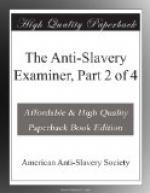I commenced my duties in August, 1834, and from the paucity of special magistrates at that eventful era, I had the superintendence of a most extensive district, comprising nearly one half of the populous parish of St. Thomas in the East, and the whole of the parish of St. David, embracing an apprentice population of nearly eighteen thousand,—in charge of which I continued until December, when I was relieved of St. David, and in March, 1835, my surveillance was confined to that portion of St. Thomas in the East, consisting of the coffee plantations in the Blue Mountains, and the sugar estates of Blue Mountain Valley, over which I continued to preside until last March, a district containing a population of four thousand two hundred and twenty-seven apprentices, of which two thousand eighty-seven were males, and two thousand one hundred and forty, females. The apprentices of the Blue Mountain Valley were, at the period of my assumption of the duties of a special magistrate, the most disorderly in the island. They were greatly excited, and almost desperate from disappointment, in finding their trammels under the new law, nearly as burdensome as under the old, and their condition, in many respects, much more intolerable. They were also extremely irritated at what they deemed an attempt upon the part of their masters to rob them of one of the greatest advantages they had been led to believe the new law secured to them—this was the half of Friday. Special Justice Everard, who went through the district during the first two weeks of August, 1834, and who was the first special justice to read and explain the new law to them, had told them that the law gave to them the extra four and a half hours on the Friday, and some of the proprietors and managers, who were desirous of preparing their people for the coming change, had likewise explained it so; but, most unfortunately, the governor issued a proclamation, justifying the masters in withholding the four and a half hours on that day, and substituting any other half day, or by working them eight hours per day, they might deprive them altogether of the advantage to be derived from the extra time, which, by the abolition of Sunday marketing, was almost indispensable to people whose grounds, in some instances, were many miles from their habitations, and who were above thirty miles from Kingston market, where prices were fifty per cent. more than the country markets in their favor for the articles they had to dispose of, and correspondingly lower for those they had to purchase. To be in time for which market, it was necessary to walk all Friday night, so that without the use of the previous half day, they could not procure their provisions, or prepare themselves for it. The deprivation of the half of Friday was therefore a serious hardship to them, and this, coupled to the previous assurance of their masters, and Special Justice Everard, that they were entitled to it, made them to suspect a fraud was about being practised on them, which, if they




